Sri Lanka Endemics Birding Tour
 19th November-1st December 2025: Sri Lanka birding highlights include Sri Lanka Spurfowl, Sri Lanka Woodpigeon, Sri Lanka Hanging Parrot, Red-faced Malkoha, Sri Lanka Frogmouth, Serendib Scops Owl, Malabar Trogon, Yellow-fronted Barbet, Crimson-fronted Barbet, Sri Lanka Grey Hornbill, Red-backed Flameback, Indian Pitta, Sri Lanka Blue Magpie, Sri Lanka Whistlingthrush, Spot-winged Thrush, Sri Lanka Thrush. – £TBA per person
19th November-1st December 2025: Sri Lanka birding highlights include Sri Lanka Spurfowl, Sri Lanka Woodpigeon, Sri Lanka Hanging Parrot, Red-faced Malkoha, Sri Lanka Frogmouth, Serendib Scops Owl, Malabar Trogon, Yellow-fronted Barbet, Crimson-fronted Barbet, Sri Lanka Grey Hornbill, Red-backed Flameback, Indian Pitta, Sri Lanka Blue Magpie, Sri Lanka Whistlingthrush, Spot-winged Thrush, Sri Lanka Thrush. – £TBA per person
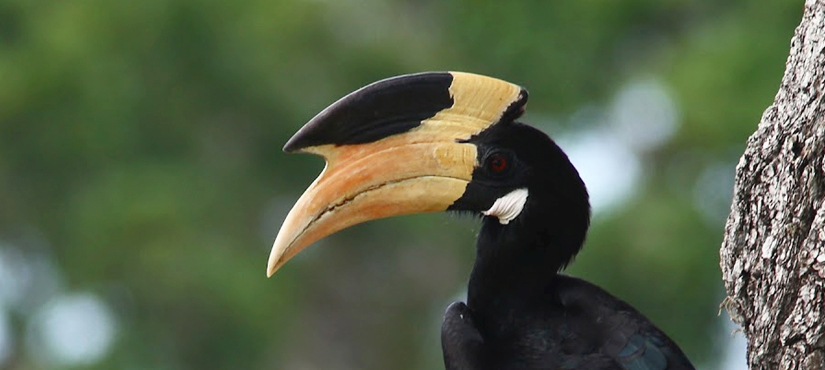
Trip Details
- Dates: 19th Nov – 1st Dec 2025
- Cost: £TBA
- Single Supplement: £TBA
- Deposit: £550
- Tour length: 13 Days (12 days birding)
- Min/Max group size: 5 / 10
- Start/Finish: Colombo
- Tour Type: Birding
- Photo Opps: Good to Very good
- Physicality: Easy but a few long days
- Leaders: Nick Upton & Local Guide
If you have any questions about this trip please feel free to ask by contacting us at info@calidrisbirdingtours.com
Sri Lanka Endemic Birding
Visiting areas of lush rainforest, village orchards, dry woodland, scrub forest, freshwater wetlands, farmland, coastal pools and city parks birding in Sri Lanka is an experience that reminds birders that variety is just as exciting as a high level of endemism. Birders come for the colourful and secretive endemic species that Sri Lanka hosts but it also supplies impressive numbers of water birds, a wide range of colourful resident and migratory Asian species, a variety of shorebirds and raptors as well as being an excellent place to see Asian Elephant, Leopard and other mammals in the wild. Sri Lanka is a country that is not only a wonderful birding location but one that supplies a wide range of wildlife and scenic experiences.
The island nation of Sri Lanka lies off of the southeast tip of India with the Bay of Bengal to the north and Indian Ocean to the south and is a safe, friendly and interesting country to travel around. Due to all of the endemic species occurring in a relatively small part of the south of Sri Lanka, this is a great destination for a compact and varied birding tour taking in a wide variety of birds. Relatively well-organised, safe and providing excellent food, birds can be found almost anywhere in Sri Lanka meaning that we are able to become familiar with many of the species we see rather than ticking them off never to see them again. With some of the best protected areas in the region rare and endemic birds are also accessible to wildlife enthusiasts with a high chance of seeing all the key species.
For those who have done a lot of birding in Asia and want to add endemic species to their list this is a perfect place to do so. Equally, Sri Lanka, with its great food, ease of travel and plentiful accommodation coupled with great variety of habitats and birds, is an excellent country for birders to make their first visit to this continent. Sri Lanka is a must for birders wishing to connect with exciting endemic birds such as Sri Lanka Blue Magpie, Serendib Scops Owl, Sri Lanka Grey Hornbill, Spot-winged Thrush and Red-backed Flameback. With superb south Asian birds that include Malabar Trogon, Great Thick-knee, Indian Pitta, Malabar Pied Hornbill and Jerdon’s Nightjar this is a trip that not only provides quality but quantity too.
Day 1, Arrival in Colombo & Transfer to Kitulgala – 19th November 2025

On arrival at Bandaranaike International Airport, Sri Lanka you will meet your guides and after a short time for refreshments/food we will transfer to our pleasant accommodation at Kitulgala. Our accommodation is in a lovely setting, overlooking a river and the forest. We should arrive in time to do our first birding around the grounds in the late afternoon. Here we are likely to see a variety of birds flying around overhead including Indian Swiftlet, Alexandrine Parakeet, Green Imperial Pigeon and perhaps small numbers of Sri Lanka Swallows.
Just birding close to our accommodation should provide a nice selection of species including endemics such as Yellow-fronted Barbet, Sri Lanka Hanging Parrot and Yellow-browed Bulbul are good candidates for early success. We will use whatever time we have here this afternoon as wisely as we can. The gardens around our accommodation are a good location for seeing a good number of the commoner species so we may well just stay there.
In the evening we have dinner along with a briefing on the trip explaining the shape of the coming days.
Day 2, Kitulgala – 20th November 2025
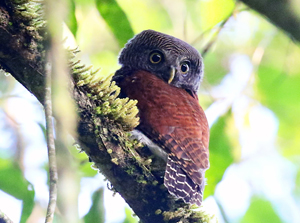
Crossing the river we enter a village strung out along a track with many large wooded gardens, forest patches and orchards all of which contain a variety of birding possibilities. The calls of barbets are hard to ignore with both Brown-headed and Yellow-fronted Barbets there for us to spot, although actually seeing a calling barbet can be more easily said than done. Sri Lanka Junglefowl can be found anywhere and Sri Lanka Hanging Parrot will zip around overhead and hopefully settle on fruiting trees. Orange-billed Babblers forage for food among the lush vegetation although less common than the ubiquitous Yellow-billed Babblers. Spot-winged Thrush will be high up our wanted list and we have a good opportunity to see them here, singing in the early morning from a favourite perch. A good number of key birds can be seen in these areas and in the early morning we have a good chance to find Chestnut-backed Owlet which we will locate from its call; this is one of the best sites to see this endemic species. Flowering and fruiting trees often attract small birds that include White-throated Flowerpecker, Loten’s Sunbird and Purple-rumped Sunbird.
The diversity of birds here is impressive with birds as varied as colourful Layard’s Parakeet and sombre Brown-chested Flycatcher, numerous Square-tailed Bulbuls with White-bellied Drongo sitting on wires. Additionally, the much-wanted Spot-winged Thrush is a possibility here too as are Legge’s Hawk Eagle soaring overhead and Sri Lanka Grey Hornbill in the forest canopy or raiding fruit in someone’s garden. Within the forest itself Sri Lanka Drongo is one of the more abundant birds while Southern Hill Myna can often be seen perched on bare branches with Tickell’s Blue Flycatcher hiding in the understorey. Seeing Sri Lanka Spurfowl can be tough indeed, but their noisy calls will at least give us a clue as to where to look.
As well as regional specialities there are a number of interesting birds that are more widespread in Asia. Stork-billed Kingfisher is always impressive, Black-naped Monarch, Oriental Honey-buzzard and Red-vented Bulbul fall into this category . Night birds are exciting possibilities here with Sri Lanka Frogmouth and Serendib Scops Owl to find, hopefully on a day roost. Our day here is sure to be a full one with a lot of new birds for most participants.
Day 3, Kitulgala-Sinharaja – 21st November 2025
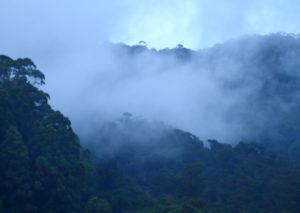
We can do a little birding around the premises of our accommodation before breakfast where perhaps a Brown-capped Pygmy Woodpecker may show up or the impressive Red-backed Woodpecker but we will depart quite early for our next site, one of the best in Sri Lanka; Sinharaja.
After lunch at our pleasantly-located accommodation we will spend the afternoon birding at Sinharaja National Park. This is an area of moist evergreen forest and is a centre of Sri Lankan endemism so we are expecting a lot of the key species here, although by the nature of the habitat many of them require patience to find. Designated as a World Heritage Site as early as 1988, the quality of the habitat matches the diversity of birds as well as reptiles, amphibians and mammals. For our time here we will be able to enjoy the good birding that this fantastic site provides from a convenient base.
Just birding along the access road and close to the lodge is likely to turn up some endemic species with possibilities including Layard’s Parakeet, Orange-billed Babbler, Pale-billed Flowerpecker, Brown-capped Pygmy Woodpecker or even the colourful Crimson-fronted Barbet or Sri Lanka Blue Magpie. Our local guides will be searching for the daytime roost of Serendib Scops Owl and with this and the next few days our chances of seeing this mysterious bird are good.
Days 4-5, Sinharaja – 22nd-23rd November 2025
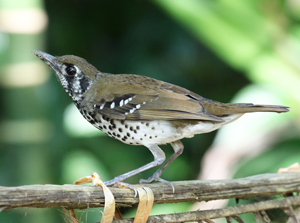
Two full days at Sinharaja will allow us a good amount of time to explore the lush forest and locate as many of the key birds as possible. Entering the forest just after dawn we will see the mist hugging the trees before it disperses and will give ourselves the best chance of find shy ground-dwelling birds as they feed in the morning such as Spot-winged Thrush or Sri Lanka (Scaly) Thrush. In the undergrowth the morning chorus should help us track down Brown-capped Babbler and Ashy-headed Laughingthrush as they wake up while in the mid storey the sight of a Malabar Trogon is sure to mesmerise us.
The search for roosting Serendib Scops Owls is likely to continue and hopefully this should turn up at least one Sri Lanka Frogmouth. Although this is not actually an endemic species any bird from this cryptic family is always a wonderful sight. More widespread birds are likely to include White-bellied Drongo, Black-naped Monarch, Lesser Yellownape, Orange Minivet and the superb Indian Paradise-flycatcher. Both Red-faced Malkoha and Green-billed Coucal lurk in the foliage but can be surprisingly tricky birds to observe given their size.
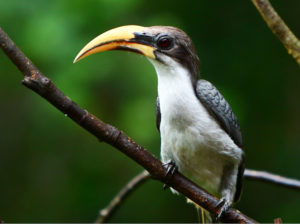
Anyone who has been birding in Asia before will have seen plenty of species of bulbul but in Sri Lanka there are a few of these birds that will surely be new for everyone. These include attractive Black-capped Bulbul as well as the more mundane Yellow-browed Bulbuls. There are a few places in this area to get really good views of Sri Lanka Blue Magpie although White-faced Starling can often prove trickier to see.
Other key birds occurring at Sinharaja include Sri Lanka Drongo, beady-eyed Dark-fronted Babbler, smart Sri Lanka Scimitar Babbler and Sri Lanka Grey Hornbill. Woodpeckers are always an exciting group of birds and here there is the chance of both Crimson-backed Flameback and Red-backed Flameback although there will be other opportunities at these spectacular birds at other sites too. One thing is for sure, there are going to be a lot of good birds here and our time will be full, enjoying the avifauna and wonderful habitat. As this area protects Sri Lanka’s highest quality remaining rainforest we are also likely to see some of the reptiles and amphibians that inhabit the forest as well as encountering Purple-faced Langurs and perhaps other mammals.
Day 6, Sinharaja-Udawalawe – 24th November 2025
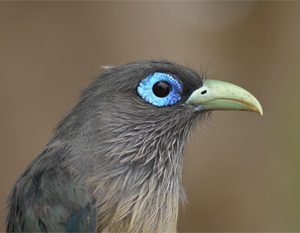
As we are staying so close to the forest we can enjoy some more birding at Sinharaja on our last morning here. If we are still looking for any key species, perhaps Sri Lanka Spurfowl has eluded us, or we can just focus on getting better views of anything that we saw only briefly. It is always good to have a little extra time in case something special has played hard-to-get or the time can be used for photography or just enjoying watching the antics of whatever turns up.
Having lunch along the way our afternoon will consist of a safari drive in Udawalawe National Park. Pools here attract Indian Peafowl, Yellow-wattled Lapwing, Great Thick-knee, Black-headed Ibis and Painted Stork while the scrub-forest contains Blue-faced Malkoha, Yellow-crowned Woodpecker, Sirkeer Malkoha, Malabar Pied Hornbill, Tawny-bellied Babbler and Black-headed Cuckooshrike. This national park can be a good location for those who enjoy raptors with a very good chance of seeing Crested Hawk Eagle along with Shikra, White-bellied Sea Eagle and Crested Serpent Eagle.
Birds such as Jungle Prinia, Indian Roller, Blyth’s Pipit and Rosy Starling can be found in the dry grassy areas but there is also a good chance of seeing mammals including Asian Elephant, Toque Macaque, Tufted Grey Langur and Sambar. At dusk forest edge is a good place for us to look for both Jerdon’s Nightjar and Indian Nightjar.
Day 7, Udawalawe-Tissa Wetlands – 25th November 2025
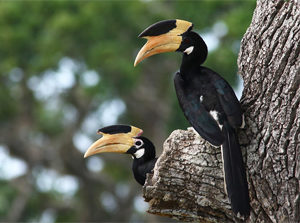
After breakfast at our hotel we visit the nearby elephant rehabilitation camp. Although we will inevitably see these animals what we are visiting this location for is a day roost of Collared Scops Owl. Once we have located these smart little birds we have time for birding around the elephant camp. The dry areas of scrub and woodland here host several interesting species that are typical to the dry zones of Sri Lanka. This site can be a very good place to catch up with Yellow-crowned Woodpecker as well as the smart Marshall’s Iora. We can expect Crested Treeswift and this is one of our chances to see Malabar Pied Hornbill – these birds are always exciting.
There is a good chance of seeing Indian Thick-knee on the stony areas while the colourful Plum-headed Parakeet sometimes shows up here in small flocks too. Small groups of colourful Chestnut-headed Bee-eaters are likely to be swooping from their perches to catch insects and species such as Black-hooded Oriole, Orange-breasted Green Pigeon, Purple Sunbird and Brown-headed Barbet are all commonly seen here. The charming Indian Robin is always a feature around this spot too.

Dry open country here is a great place to see good numbers of Ashy-crowned Sparrow Larks as well as one of just a few opportunities for us to find Jerdon’s Bushlark. Oriental Skylark can be added to the list at this spot too while Yellow-eyed Babbler, Ashy Prinia and Tawny-bellied Babbler should be found in the grasses/scrub and we might get a lesson in the identification of Blyth’s Pipit. Hopefully we can find a Grey-bellied Cuckoo or two in this area.
After this we will drive to our accommodation at Tissamaharama where we will check in, have lunch and take a bit of a rest in the heat of the day. Later, in the afternoon, we can visit lakes in this area which are usually teeming with water birds. With areas of mud, open water and floating vegetation there is likely to be large numbers of Great, Little, Eastern Cattle and Intermediate Egrets feeding as well as Grey and Purple Herons. This is a great opportunity for us to see a few rather trickier to see birds too in Yellow and Cinnamon Bitterns plus this is good site for finding a handsome Black Bittern or two. Among this profusion of species we are likely to also find Black-headed Ibis, a few Eurasian Spoonbills, Grey-headed Swamphen, Pheasant-tailed Jacana, perhaps a few Spot-billed Pelicans and Asian Openbills. Cotton Pygmy Goose is a very attractive little bird and we should spot some of these hiding among floating vegetation while Lesser Whistling Duck will be more obvious.
With all this water around kingfishers should be in evidence. We can count on White-throated Kingfisher and the sight of Pied Kingfisher is always lovely. We might be able to locate the massive Stork-billed Kingfisher as colourful as it is impressive in size. Fringing trees should provide us with more than just water birds and in fact Rose-ringed Parakeet might just be the most obvious bird here while Indian Paradise-flycatcher, Pied Cuckoo, Sri Lanka Woodshrike, Tricoloured Munia and Streaked Weaver will all vie for our attention. More sightings of the stunning Red-backed Flameback are likely here and this is probably our best chance of seeing the scarce White-naped Woodpecker on one of the large trees here. Local guides can often take us to see roosting owls here and if there are species that we haven’t yet seen we can find time to fit these in too.
A few smaller birds back in the wet area could include Ashy Prinia or Clamorous (Indian) Reed Warbler and we will be back to our hotel for dinner and an early night in preparation for an early start the following day.
Day 8, Yala National Park – 26th November 2025

Today will be a long day but surely one to remember. Leaving our accommodation early we will take a packed breakfast to maximise our time in the field. Using off-road, safari-type vehicles, we will spend all day in Yala National Park, possibly Sri Lanka’s most famous wildlife-watching destination. Designated in 1938 this is Sri Lanka’s second largest national park. We expect to enter the national park at around dawn, giving us the whole day to explore the wetlands, grasslands, scrub forest and dry woodland patches of this area. Here there are plenty of birds as well as the potential to see a good number of mammals including Asiatic Elephant and Leopard.
In the early morning some birds of open, dry woodland should be quite active, with the call of Coppersmith Barbet from the trees to busy little White-browed Fantail darting around in the understorey. Eurasian Hoopoe is always an impressive bird but more range-restricted species that we can find in the dry woodland include Sirkeer Malkoha, Yellow-crowned Woodpecker and Malabar Pied Hornbill while the flashy Indian Peafowl can be found more or less anywhere here. Sri Lanka Woodshrike is another bird to look out for along with Crested Treeswift with its amazingly long wings, Small Minivet, Marshall’s Iora and Jungle Prinia. This represents a good chance for many birders to catch up with Orange-breasted Green Pigeon, a bird that can be tricky to find through much of its range. The dry woodland is also one of our better chances of locating the colourful Crimson-backed Flameback, although there will be other chances.
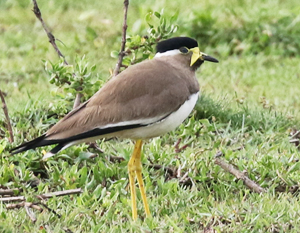
We are likely to come across Asian Elephant anywhere around the national park and their presence is one of the reasons we have to stay in the safari vehicles most of the time. The wetland areas are likely to be very productive for us with dry areas adjacent to them one of the best places to spot mammals. These mammals are likely to include Spotted Deer (Chital), Wild Boar, Ruddy Mongoose and groups of Tufted Grey Langur but if we manage to find a Leopard or Sloth Bear we can consider it a very good day indeed. With our driver in contact with other guides and drivers there is a good chance that we will get on to a leopard; fingers crossed! Open areas are also our best chance of finding Jerdon’s Bushlark if we did not see it before, while Ashy-crowned Sparrow Lark should be fairly numerous. Groups of Brahminy Starlings and handsome Rosy Starlings will also be a pleasant distraction.
Wetland birding at Yala is going to provide another opportunity to see some cool birds too. Yellow-wattled Lapwing can usually be found here as well as its noisy cousin Red-wattled Lapwing. If the conditions are right there should be a helping of smaller waders too. These can include Kentish Plover, Lesser Sand Plover, Marsh Sandpiper and Little Stint. However, the main prize among this group of birds is Great Thick-knee, an impressive bird with its freaky, oversized bill. This species is in decline through much of its range but there is a healthy population here and if we are fortunate we may also find Small Pratincole. Larger water birds include small numbers of elegant Eurasian Spoonbill, Spot-billed Pelican, Painted Stork, Woolly-necked Stork while it will take more effort and plenty of scanning to find the prehistoric Lesser Adjutant and Black-necked Stork.
There is plenty for us to see at Yala National Park and it is the best location for us to see some species on this trip as well as one of a few chances on this itinerary for a whole host of Sri Lanka’s birds. We always like to have more than one shot at most species.
Day 9, Bundala National Park -Nuwara Eliya – 27th November 2025

An early start gets us to the coastal lagoons at Bundala National Park. Driving down tracks we can access salt pans and lagoons where we expect large numbers of shorebirds and terns. Groups of huge Caspian Terns with their deep orange bills usually contain Gull-billed Terns and Whiskered Terns. We can also check for small numbers of White-winged Tern and perhaps other species such as Greater Crested Tern or Lesser Crested Tern. Separating Little Tern from Saunders’s Tern will not be easy should we find some.
Checking the shorebirds should reveal Lesser Sand Plover, Kentish Plover, Marsh Sandpiper, Curlew Sandpiper, Pacific Golden Plover and Little Stint. If we scan through the groups of birds carefully we should pick out other species in small numbers, perhaps Ruddy Turnstone, Red-necked Phalarope and Small Pratincole. We will also hope to spot Pin-tailed Snipe in more freshwater areas. The cryptic Indian Thick-knee occurs in the drier areas where we are also likely to see Oriental Skylark and Paddyfield Pipit.

Some areas a little further inland contain freshwater pools and it is here that we might locate the rare Black-necked Stork and perhaps Clamorous Reed Warbler singing from the top of emergent vegetation. Smart Ashy-crowned Sparrow Larks are likely nearby and this location provides another chance to get a good look at Crested Hawk Eagle. Some small mammals can feature here too with Black-naped Hare, Grey Mongoose and Ruddy Mongoose inhabiting the dry, scrubby areas.
By mid-morning we start traveling into the highlands, through the tea plantations to the town of Nuwara Eliya. This colonial hill station provides us with a more temperate climate as well as some scenery and architecture that has earned the area the nickname “Little England”. Our prime focus will be Victoria park which, although busy in the middle of the day, as the afternoon draws to a close we hope for a close-encounter with Indian Pitta. This lovely bird can be quite confiding, feeding on the lawns when things are getting quiet and cooler. Another key species at this location is the superb Pied Thrush. Pied Thrush may not be an endemic species but the male is a stunning bird and will be one of the candidates for bird of the trip for some people. Like many thrushes this is a shy bird but if we search quietly along the streamside we have a good chance of seeing this beauty. Indian Blue Robin is another highlight species to look for in the most unkept parts of the park.
Day 10, Horton Plains National Park – 28th November 2025
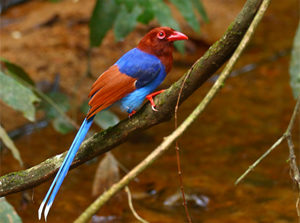
We make an early start to get to Horton Plains National Park for dawn. Being here early is important as this is one of the best places to find the extremely shy Sri Lanka Whistlingthrush. Waiting quietly near secluded pools or near a rocky stream, the sort of places this bird likes early in the day, give us the best chance. This will be one of the trickier Sri Lankan endemics to find so we will put a lot of effort into this early on. We should find an Indian Blackbird or two as we go uphill towards the plateau while another of our key targets is Dull-blue Flycatcher. Walking along trails through the dense vegetation we expect to be able to encourage Sri Lanka Bush Warbler to emerge and allow us to see it and this is also an excellent place to see both Sri Lanka White-eye and Sri Lanka Woodpigeon. Once we have located all the key species we can wander around and enjoy some nice birding in some nice habitat. We have another chance of seeing some other endemic species in Yellow-eared Bulbul, Sri Lanka Scimitar Babbler and Crimson-backed Flameback but there will be plenty of other birds too.
For those who like the challenge of Phylloscopus warblers there are Large-billed and Green Leaf Warblers to look for. The very scarce Kashmir Flycatcher frequents this site so we will try hard to see this bird and species such as Cinereous Tit, Velvet-fronted Nuthatch and Grey-headed Canary Flycatcher can form small flocks. We might have another chance to see the impressive Sri Lanka Blue Magpie while on the grassy “plains” themselves Pied Bushchat should be easy enough to spot. Having maximised our time here we eventually descend, heading back to our hotel but not before stopping to enjoy watching Hill Swallows swooping around over farmland or perched on wires. Back at the hotel Blyth’s Reed Warbler can often be found in the gardens.
Day 11, Hakgala Botanical Gardens – 29th November 2025

Remaining in the hill country we will spend the morning at Hakgala Botanical Gardens. Botanical gardens are often a good place to find some key species as well as get good views of some of the more common birds. This is true of Hakgala being situated adjacent to Hakgala nature reserve forming a large area of protected habitat. Visiting secluded and unkempt parts of the gardens will give us another excellent chance of finding Dull-blue Flycatcher, perhaps lurking around a damp area or compost heap. Yellow-eared Bulbuls flit from tree to tree while commoner birds include Cinereous Tit, Bar-winged Flycatcher-shrike, Yellow-eared Bulbul, Red-vented Bulbul and Sri Lanka White-eye.
Grey-headed Canary-flycatcher is usually a very friendly species here and Yellow-fronted Barbet can often be quite confiding. Square-tailed Black Bulbul is likely in the trees but there could be a few surprises as we spend our time looking for Kashmir Flycatcher, this being one of the best sites for this scarce bird. There is also another chance of a couple of other shy and difficult-to-find birds that include Sri Lanka (Scaly) Thrush and Sri Lanka Bush Warbler. Common birds that can be found on the ground include Forest Wagtail, Oriental Magpie Robin and Grey Wagtail. By visiting a variety of sites we maximise our chances of finding birds such as these which are easily missed if in a rush.
After lunch at our accommodation we can visit areas around Nuwara Eliya perhaps revisiting Victoria Park to look for Indian Pitta and Pied Thrush. Perhaps we will visit another site if Slaty-legged Crake has been seen there recently. There is also the possibility to look for Brown Wood Owl in one of the tea-growing areas.
Day 12, Nuwara Eliya- Kandy – 30th November 2025

If we are still looking for any of the key species of the area we have plenty of time to look for them this morning, revisiting any of the previous sites as required or finding another location for them, particularly if we missed Sri Lanka Woodpigeon.
After lunch we will start our journey towards Bandaranaike International Airport and check in to a hotel nearby before having a final dinner together, discuss our sightings and vote for bird of the trip.
Day 13, Departure – 1st December 2025
Our Sri Lanka Endemics Birding Tour will conclude with a transfer from our hotel to Bandaranaike International Airport at a time suitable for our onward flights.
The following is a list of species that we have a high chance of seeing on this birding tour based on the experience of previous visits. It is not meant as an exhaustive list of target species but they birds that we think are highlights because of they are memorable and/or range-restricted. Our efforts will most certainly be focussed on getting the best views that we can of Sri Lanka’s endemic species followed by the many other regional specialities. Of course we cannot guarantee that we will see all of these birds but we do expect to locate a high proportion of them.
- Sri Lanka Spurfowl – Galloperdix bicalcarata
- Sri Lanka Junglefowl – Gallus lafeyeti
- Indian Peafowl – Pavo cristatus
- Cotton Pygmy Goose – Nettapus coromandelianus
- Painted Stork – Mycteria leucocephala
- Woolly-necked Stork – Ciconia episcopus
- Black-necked Stork – Ephippiorhynchus asiaticus
- Lesser Adjutant – Leptoptilos javanicus
- Black Bittern – Dupetor flavicollis
- Spot-billed Pelican – Pelicanus philippensis
- Grey-headed Fish Eagle – Icthyophaga ichthyaetus
- Legge’s Hawk Eagle – Nisaetus kelaarti
- Great Thick-knee – Esacus recurvirostris
- Sri Lanka Woodpigeon – Columba torringtoniae
- Sri Lanka Green Pigeon – Treron pompadora
- Sri Lanka Hanging Parrot – Loriculus beryllinus
- Layard’s Parakeet – Psittacula calthropae
- Blue-faced Malkoha – Phaenicophaeus viridirostris
- Sirkeer Malkoha – Taccocua leschenaultii
- Red-faced Malkoha – Phaenicophaeus pyrrhocephalus
- Green-billed Coucal – Centropus chlororhynchos
- Sri Lanka Frogmouth – Batrachostomus moniliger
- Jerdon’s Nightjar – Caprimulgus atripennis
- Serendib Scops Owl – Otus thilohoffmanni
- Chestnut-backed Owlet – Glaucidium castanotum
- Sri Lanka Bay Owl – Phodilus assimilis
- Malabar Trogon – Harpactes fasciatus
- Brown-headed Barbet – Psilopogon zeylanicus
- Yellow-fronted Barbet – Psilopogon falvifrons
- Crimson-fronted Barbet – Psilopogon rubricapillus
- Sri Lanka Grey Hornbill – Ocyceros gingalensis
- Malabar Pied Hornbill – Anthracoceros coronatus
- Brown-capped Pygmy Woodpecker – Yungipicus nanus
- Red-backed Flameback – Dinopium psarodes
- Crimson-backed Flameback – Chrysocolaptes stricklandi
- White-naped Woodpecker – Chrysocolaptes festivus
- Indian Pitta – Pitta brachyura
- Sri Lanka Woodshrike – Tephrodornis affinis
- Jerdon’s Leafbird – Chloropsis jerdoni
- Sri Lanka Blue Magpie – Urocissa ornata
- Sri Lanka Swallow – Cecropis hyperythra
- Sri Lanka Drongo – Dicrurus lophorinus
- Jerdon’s Bushlark – Mirafra affinis
- Black-capped Bulbul – Pycnonotus melanicterus
- Yellow-eared Bulbul – Pycnonotus penicillatus
- White-browed Bulbul – Pycnonotus luteolus
- Yellow-browed Bulbul – Acritillas indica
- Sri Lanka Bush Warbler – Elaphrornis palliseri
- Blyth’s Reed Warbler – Acrocephalus dumetorum
- Large-billed Leaf Warbler – Phylloscopus magnirostris
- Brown-capped Babbler – Pellorneum fuscocapillus
- Sri Lanka Scimitar Babbler – Pomatorhinus melanurus
- Dark-fronted Babbler – Rhopocichla atriceps
- Tawny-bellied Babbler – Dumetia hyperythra
- Orange-billed Babbler – Turdoides rufescens
- Ashy-headed Laughingthrush – Garrulax cinnereifrons
- Sri Lanka Hill Myna – Gracula ptilogenys
- Southern (Lesser) Hill Myna – Gracula indica
- White-faced Starling – Sturnornis albofrontatus
- Sri Lanka Whistlingthrush – Myophonus blighi
- Pied Thrush – Zoothera wardii
- Spot-winged Thrush – Zoothera spiloptera
- Sri Lanka Thrush – Zoothera imbricata
- Indian Robin – Saxicoloides fulicatus
- Kashmir Flycatcher – Ficedula subrubra
- Dull-blue Flycatcher – Eumyias sordidus
- Legge’s Flowerpecker – Dicaeum vincens
- Purple-rumped Sunbird – Nectarinia zeylonica
- Loten’s Sunbird – Nectarinia lotenia
- Sri Lanka White-eye – Zosterops ceylonensis
This map below illustrates the route around southern Sri Lanka taken on this endemic birds tour. The main locations to visit are numbered but there may be some other birding stops between them.
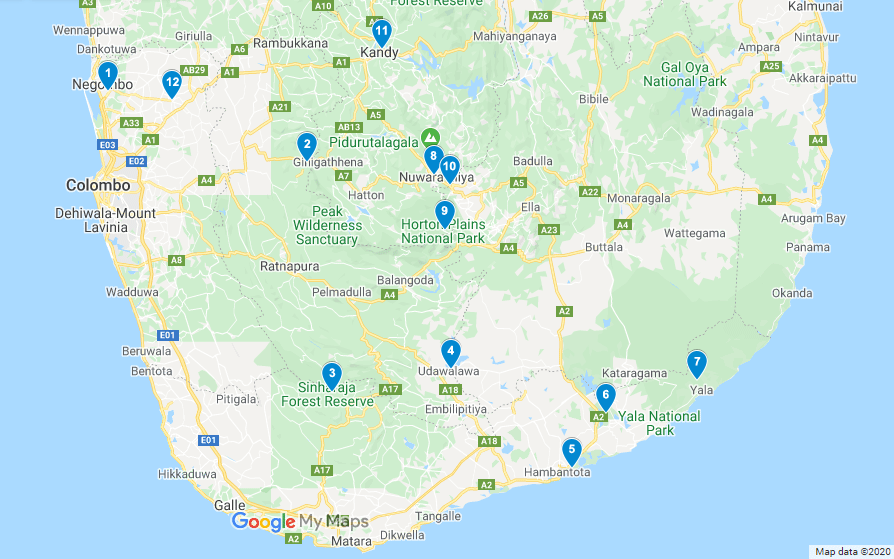
1. Bandaranaike International Airport
5. Bandala National Park
9. Horton Plains National Park
2. Kitulgala
6. Tissa Wetlands
10. Hakgala Botanical Gardens
3. Sinharaja Forest Reserve
7. Yala National Park
11. Kandy/Uddawattakele
4. Udawalawe
8. Nuwara Eliya
12. Veyangoda
The following is a selection of birds and other wildlife from this Sri Lanka birding tour.

Indian Peafowl 
Velvet-fronted Nuthatch 
Grey Langur 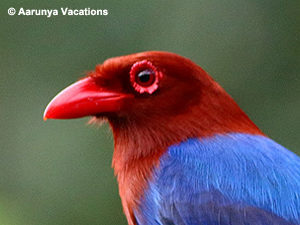
Sri Lanka Blue Magpie 
Asian Elephant 
Painted Stork 
Sri Lanka Frogmouth 
Indian Blue Robin 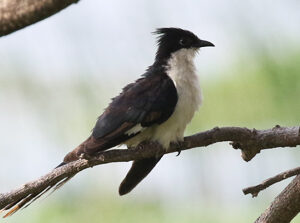
Pied Cuckoo 
Jungle Owlet 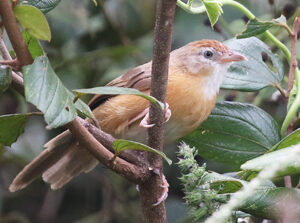
Tawny-bellied Babbler 
Green Imperial Pigeon
Tour Details
Tour Cost: £TBA
Single Supplement: £550
Included in the tour cost; All transport including airport transfers, all accommodation within Sri Lanka (based on two people sharing a room), all meals, bottled drinking water, national park entry fees and permits, services of English-speaking birding guide, translator and Calidris Birding Tours guide.
Not included in the tour cost; International flights, travel insurance, entry visa, alcoholic and soft drinks, tips, laundry, hotel mini bar, phone calls and any other items of a personal nature.
Accommodation: All accommodation is convenient to birding sites and for making logistics as simple as possible. Rooms at all sites have en-suite shower and toilet facilities. All rooms in hot, lowland areas have air-conditioning but some of the rooms at higher altitude are fan-cooled where lower temperatures are normal. Our lodge at Sinharaja is basic but clean, serves good food and is right next to the forest. Wifi is available at most accommodations, either in the rooms or in public areas. However, for our three nights at Sinharaja there will be no internet connection.
Physical effort: Birding in Sri Lanka does not take any great physical effort. However, participants must be fit enough to walk on undulating forest trails at some places although at a number of locations birding will be done from a safari vehicle. Any able-bodied person with decent mobility will be able to deal with this birding tour. There will be some long days in the field when searching for key species but the itinerary has been designed so that there is not too much time pressure and there are likely to be a few early finishes.
Weather: We can expect a range of temperatures on this trip. The lowlands will be hot with quite high humidity around wetland areas. However, when we visit higher altitude regions for forest birds we can expect much cooler temperatures, around Nuwara Eiya, for example, average temperatures are below 20C at this time of year. We can, perhaps, expect a few showers, particularly in the late afternoon/evening, so be prepared for a variety of weather but nothing extreme.
Food: Sri Lankan cuisine is excellent, being influenced heavily by South Indian and Southeast Asian cooking. Most meals consist of steamed rice and a variety of stir-fried dishes and/or curries. Influence from the Malay community means that some simple fried noodle dishes are also available. Vegetarian food is easy to obtain and is excellent. Vegans and those with food allergies can be catered to but please tell us in advance of any special eating requirement so that we can check.
Tour Leaders

Nick Upton
Nick Upton has been birding since the age of seven and leading birding tours full-time since 2007. After travelling extensively in Asia he settled in Thailand in 1997, teaching English and science while establishing thaibirding.com. With a BSc (Hons) Wildlife & Countryside Conservation he is well placed to understand the ecology of birds as well as the conservation issues that affect them.
Nick is co-founder/director of Calidris Birding Tours.
While we make every effort to adhere to the advertised itinerary for this Sri Lanka endemics birding tour, we reserve the right to make changes in the case of unforeseen circumstances that are beyond our control. These include problems with accessibility, national park closures, unseasonal weather events or any other reason that may force us to make changes.
Recommended Field Guide
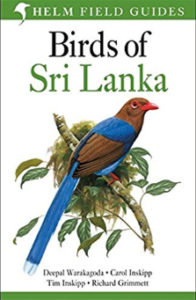 Birds of Sri Lanka
Birds of Sri Lanka
This field guide covers all of the species to be found in Sri Lanka and is the most up-to-date field guide currently available. The only alternatives are photographic guides which are of insufficient quality for use in the field. It contains all the currently recognised endemic species and highlights some others which may be split in the future. We recommend that all participants on this Sri Lanka bird watching tour obtain a copy well in advance of the trip commencing in order to become familiar with the birds we expect to see.
The checklist that Calidris Birding Tours will issue for this trip will use IOC taxonomy with reference to the taxonomy used within this field guide so that it is relevant to both.
Read our full review here – Birds of Sri Lanka
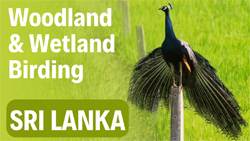 Sri Lanka Wetland Birding Adventure; Tissamaharama
Sri Lanka Wetland Birding Adventure; Tissamaharama
In this Sri Lanka virtual birding video we visit the ancient, shallow irrigation reservoirs of Tissamaharama, known locally as “tanks”. In reality these reservoirs are full of biodiversity with a wide variety of birds and it was exciting to explore the habitats and birds here over the course of a couple of days. Birds such as Indian Peafowl, White-naped Woodpecker, Great Thick-knee and Grey-headed Fish Eagle are some of the birding highlights but there are many other species of birds to enjoy.
Spot-winged Thrush, Geokichla spiloptera, is an endemic species of bird to Sri Lanka, one of 33 currently recognized endemic bird species for the country. Like many other thrushes, Spot-winged Thrush is an excellent songster with lots of sweet phrases and snatches of mimicry of other birds. This one was in the forest at Kitulgala on a bright but steamy morning and at times it mimicks the call of Brown-capped Babbler (another endemic species to Sri Lanka) .
Related Blog Posts
- Forest Birding at Kitulgala – posted by Nick Upton 05/05/22
- Back of an Airport Hotel Birds; Sri Lanka Birding – posted by Nick Upton 22/03/22
- Sinharaja Forest Reserve – posted by Miles to the Wild 12/03/14
- Yala National Park – posted by Bucks Birders in Sri Lanka 15/02/14
Terms and conditions: Please read full Calidris Birding Tours terms and conditions which apply to the Sri Lanka Endemics Birding Tour.



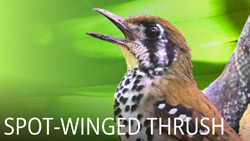 Spot-winged Thrush Singing
Spot-winged Thrush Singing